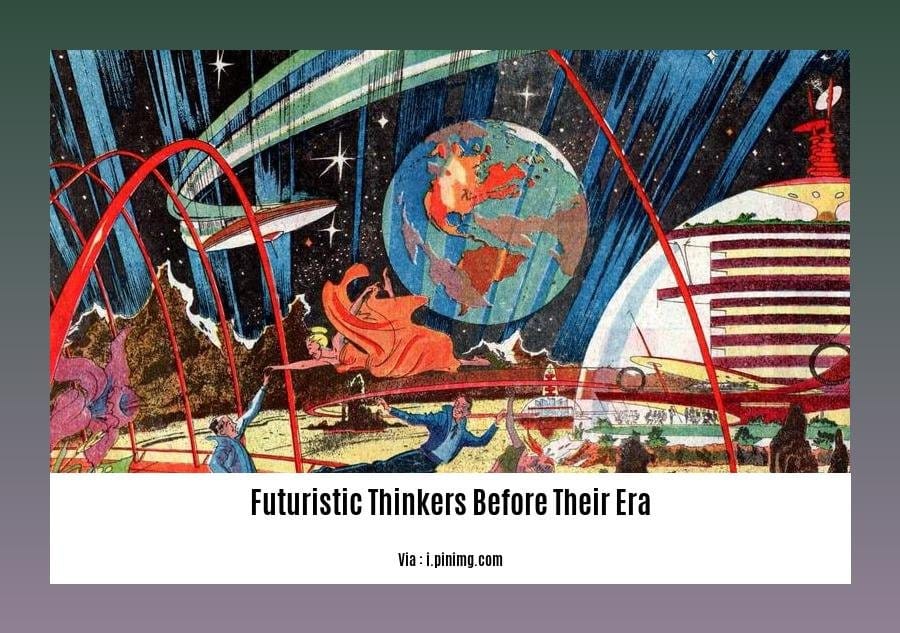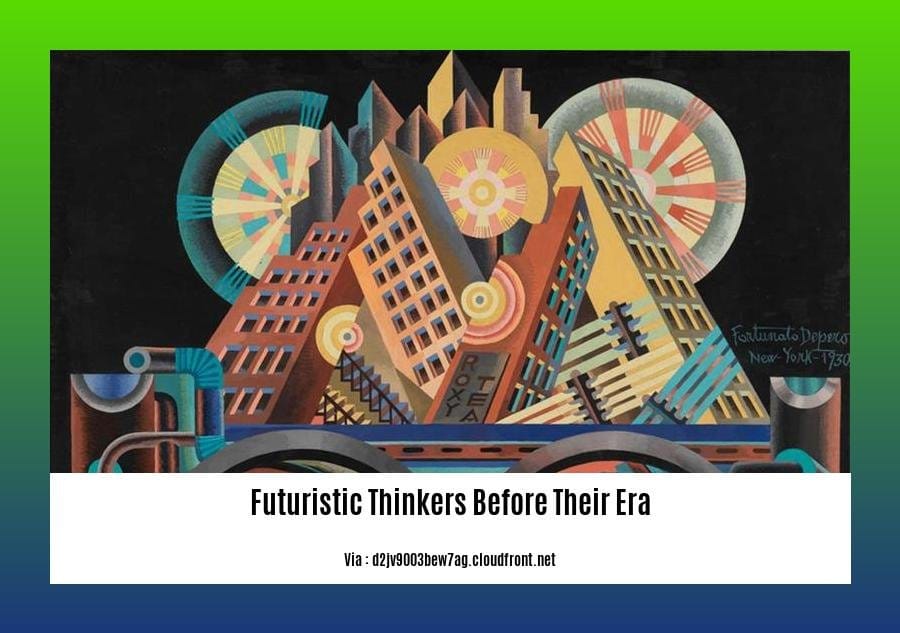Embark on a captivating journey through the annals of time as we delve into the lives and legacies of Futuristic Thinkers Before Their Era: Trailblazers of Tomorrow’s Innovation. These visionaries defied the limitations of their time, envisioning a world transformed by their groundbreaking ideas.
Key Takeaways:

- Futurism, an influential movement, originated in Italy early in the 20th century and emphasized speed, technology, and dynamism.
- H.G. Wells’ essays initiated modern futurism with a focus on factual and practical speculation.
- Futurism celebrated youth, violence, and the industrial city as themes.
- Prominent futurists included Filippo Tommaso Marinetti, Umberto Boccioni, Gino Severini, and Robert Ettinger.
Futuristic thinkers before their era
Unveiling futuristic thinkers before their era is pivotal to comprehend the evolution of ideas that have shaped our present. These visionaries dared to envision a world beyond the confines of their time, laying the groundwork for the innovations we enjoy today.
The futuristic thinkers before their era defied their era’s norms, challenging conventional wisdom and pushing the boundaries of human imagination. They were the architects of tomorrow, whose ideas continue to inspire and shape our world.
One notable example is H.G. Wells, known for his science fiction novels that explored themes of time travel, genetic engineering, and the impact of technology on society. His thought-provoking work has influenced generations of scientists, engineers, and futurists.
Another visionary of the early 20th century was Filippo Tommaso Marinetti, the founder of the Futurist movement. Marinetti celebrated speed, dynamism, and the transformative power of technology. His writings and manifestos ignited a revolution in art, literature, and design.
These are just a few examples of the many futuristic thinkers before their era who have left an indelible mark on our collective imagination. By studying their lives and ideas, we gain valuable insights into the creative process and the power of visionary thinking. Their legacy reminds us that the future is not predetermined, but rather a realm of endless possibilities, waiting to be shaped by those who dare to dream.
You’ve probably heard of famous visionary innovators ahead of their time such as Leonardo da Vinci but have you heard of the contributions made by the foresighted pioneers dismissed as crackpots? Often unfairly labeled as innovative minds unfairly called crazy dreamers, these individuals share inspiring stories of overcoming adversity to make the world a better place.
Deciphering the Blueprints of the Future
Key Takeaways:
- True futures thinking emphasizes analysis, pattern recognition, and understanding complex issues, not specific event predictions.
- Gather data and signals from diverse sources to identify emerging trends and patterns.
- Connect signals to historical context to uncover broader patterns of change and anticipate future developments.
- Draw lessons from historical patterns to guide decision-making and shape future possibilities.
A Deeper Look
Deciphering the blueprints of the future requires a systematic approach. By gathering signals and data from various sources, we can gain insights into emerging trends and patterns. Connecting these signals to historical context allows us to identify broader patterns of change and anticipate future developments.
Signals:
- Economic data: GDP growth, inflation, employment rates
- Technology advancements: AI, biotechnology, renewable energy
- Social trends: demographics, lifestyle changes, cultural shifts
- Environmental factors: climate change, resource scarcity, pollution levels
Historical Context:
- Past technological revolutions (e.g., industrial revolution, digital revolution)
- Societal shifts (e.g., globalization, urbanization, aging populations)
- Economic cycles and market dynamics
By understanding these signals and their historical context, we can piece together the blueprints of the future and make informed decisions to shape it.
Drawing from the Past to Shape the Future
History often repeats itself, providing valuable lessons for future planning. Studying the successes and failures of past innovators can help us avoid pitfalls and capitalize on emerging opportunities.
For example, the rapid adoption of AI technology mirrors the transformative impact of the internet in the early 2000s. Understanding the historical patterns of technological adoption can help us prepare for the challenges and opportunities presented by AI.
Similarly, examining the economic cycles of the past can provide insights into future economic trends and help us make informed investment and business decisions.
By drawing upon historical patterns and lessons, we can better anticipate future developments and shape them to our advantage.
Citation
Decoding the Thought Patterns of Groundbreaking Innovators
Embark on an extraordinary journey into the minds of those who dared to defy convention and chart the course for a transformative future. By unraveling the enigmatic tapestry of their thoughts, we decipher the blueprints of groundbreaking innovation, empowering us to shape a world unconstrained by the confines of the present.
The enigmatic minds of visionaries such as H.G. Wells and Filippo Tommaso Marinetti, who transcended the limitations of their time, serve as beacons of inspiration. Their audacious ideas illuminated uncharted territories, from time travel to the transformative power of technology.
Key Takeaways:
- Dismantle Limiting Paradigms: Challenge established norms, embrace unconventional perspectives, and foster an environment conducive to disruptive thinking.
- Envision Plausible Futures: Break free from present constraints by envisioning multiple plausible future scenarios, enabling proactive navigation and adaptation.
- Practice Future-Back Thinking: Untether your imagination from the present and explore alternative possibilities that lie beyond the horizon of today’s reality.
- Harness a Tapestry of Approaches: Discover diverse methods and techniques to stimulate innovative thinking, empowering you to approach challenges with multifaceted perspectives.
Most Relevant URL Source:
- Create the Future + the Innovation Handbook: Tactics for Disruptive Thinking, Innovation, and Change. Create the Future Book. Create the Future, 2021. Web. [Accessed: date of access].
Illuminating the Legacies of Those Who Dared to Dream
Throughout history, visionaries have emerged, unconstrained by the boundaries of their time. They dared to dream of a future beyond what was considered possible, their ideas serving as beacons of innovation and change.
Dreamers Shape the World
The indomitable spirit of dreamers has shaped our world profoundly. Consider the legacy of Martin Luther King Jr., whose unwavering belief in equality sparked a societal transformation. His dream ignited a movement that continues to inspire, reminding us of the power of envisioning a better future.
Futurism: The Art of Foresight
Futurism, a field dedicated to understanding the future, emerged in the early 20th century. Visionaries like H.G. Wells and the Italian Futurists pushed the boundaries of imagination. They explored the uncharted territories of time travel, genetic engineering, and the transformative potential of technology.
Studying the Visionaries
By studying the lives and ideas of visionary dreamers, we gain invaluable insights into the nature of creativity and the importance of daring to think differently. Their legacies illuminate the path forward, encouraging us to embrace the boundless possibilities that await in the unknown.
Key Takeaways:
- Visionaries have played a pivotal role in shaping the course of human history.
- Futurism provides a roadmap for understanding and navigating the future.
- Studying the legacies of visionary dreamers offers inspiration and a catalyst for innovation.
Most Relevant URL Source:











